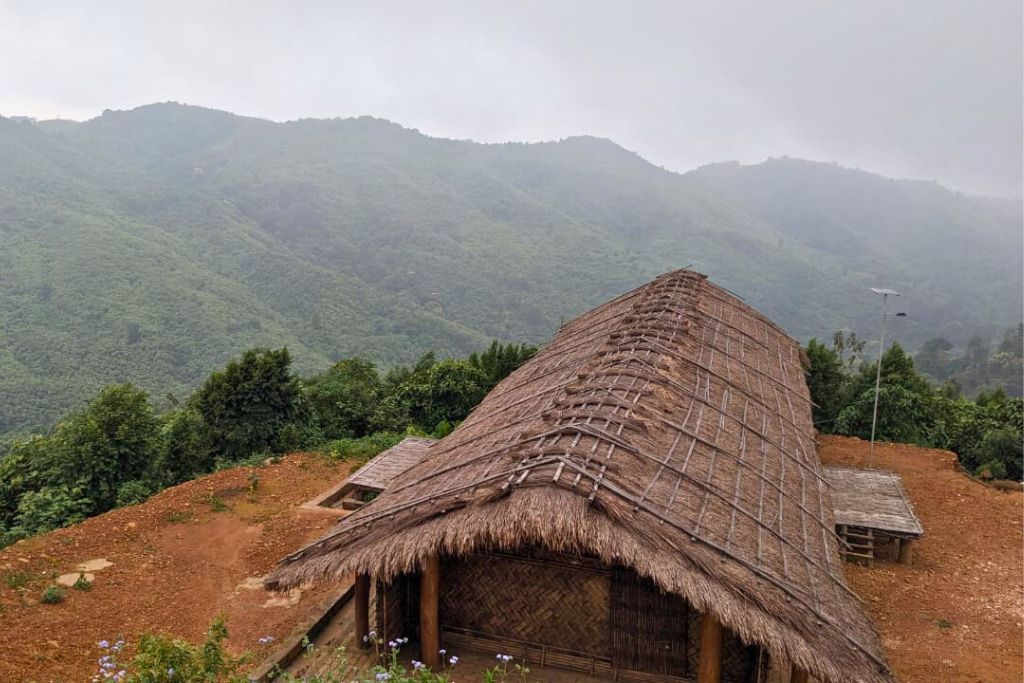
Life at Daribokgre village in Meghalaya
Meghalaya is home to three prominent communities - Khasi, Garo and Jaintia. Garos comprise the second-largest tribe in the state. Let's explore a Garo village and their way of life.
Nestled in the East Garo hills, in the periphery of the Norkrek Biosphere Reserve in Meghalaya, is the beautiful quaint village of Daribokgre. Home to around 35 households, this village is a popular destination to learn about the Garo community’s traditional way of living. (Photo by Navmalika Sidhu)
Daribokgre is inhabited by the Garo people, known for their unique matrilineal customs. The property is inherited by the youngest daughter in the family. They also practise uxorilocality, wherein the couple lives with or near the wife’s parents rather than the other way around. (Photo by Vivek V Dev)
Women here typically wear traditional Garo clothing, consisting of a dak manda (a cotton or silk wrap skirt), a blouse and a chunni, even for their everyday tasks. (Photo by Vivek V Dev)
The Garo community in Daribokgre, known in the local language as achik mande or “people of the hills,” predominantly follows the Christian faith. The village has one church that holds service every Sunday. (Photo by Navmalika Sidhu)
The houses, built by the family members themselves, are made of bamboo as they provide great insulation from the heat and the cold. The kitchen is equipped with a mud stove on which everything is cooked. (Photo by Navmalika Sidhu)
Also Read: Bamboo, a miracle material in Meghalaya
Families in Daribokgre typically have 5-6 children, with kids attending school in the village or in the nearby village of Chandigre. For higher classes, they travel to Rongkhon. During their free time, the children like to swim in the local rivers, Didare and Simsang. (Photo by Navmalika Sidhu)
Rice, locally called mi, is the staple food eaten for every meal, including breakfast. Rice flour is also used to make a few baked goods and snacks. The other dishes consist of fish, pork, red meat and locally grown vegetables that are mostly steamed or boiled. The villagers go down to the Didare and Simsang rivers for fishing. Freshly prepared on a mud stove, lal cha (red tea) is a sweet hot beverage enjoyed by the villagers. (Photo by Navmalika Sidhu)
The tropical climate with monsoon rainfall occurring from April to October is ideal for the farmers here to grow vegetables and fruits like pumpkin, pineapple, jackfruit, plums, pears, beans, ladyfinger, squash and cucumber. The Garo village also produces homemade jams and juices from their produce. Orange orchards can be spotted in abundance in the village. (Photo by Navmalika Sidhu)
Also Read: The elephant and the honey bee: Are there lessons for Meghalaya and Tripura?
Grocery runs are usually done every Friday on a pickup truck. A member or two from each family go into a neighbouring town called Rongram to get supplies for the coming week. The villagers are not usually employed, most of them have historically earned an income by selling rice and vegetables at local markets. (Photo by Navmalika Sidhu)
The starting point for the trek to Nokrek peak, the highest peak of the Garo hills rising up to 1,412 metres, is in Daribokgre. Hoolock gibbons, India’s only primate species, is also endemic to this forest. Additionally, Nokrek National Park is the cradle of all of India’s citrus fruits including Citrus indica (Indian wild orange) and Citrus macroptera. It is open on all days except Sunday. (Photo by Navmalika Sidhu)
Football is a major sport in this Garo village, with men participating in local tournaments played in the local common ground. (Photo by Navmalika Sidhu)
The lead image at the top shows a traditional Garo house built at the ‘view point’, a popular tourist destination that lends scenic views of the hills.
Text by Navmalika Sidhu. Navmalika is a freelance content writer who writes about sustainability in fashion, craft revival and consumer awareness in the fashion industry.










